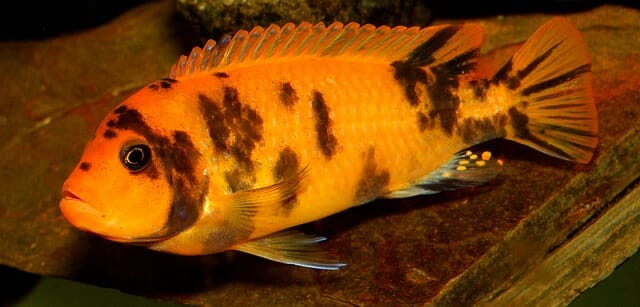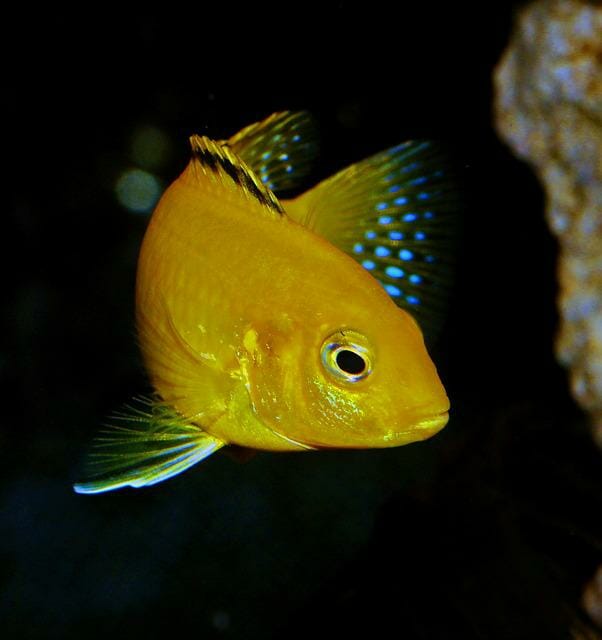Are Peacock Cichlids Herbivores: Diet, Feeding, Species Overview & Care Guide

Peacock cichlids are fascinating fish to keep in the home aquarium. They come in a wide variety of colors and patterns and are known for their lively and playful personality. Plus, they’re an excellent choice for any beginner fishkeeper.
As cichlids go, the peacock is a pretty unusual creature. While many fish are carnivores, the peacock can be a herbivore. This means that this cichlid primarily eats plant material rather than meat. In general, though, many experts consider peacock cichlids as omnivores. While some people might find this diet strange, it makes sense for the peacock cichlid. These fish live in tropical areas with plenty of plants to eat.
Without a solid predatory instinct, herbivores like the peacock can easily survive and reproduce. In addition to eating plants, the peacock also uses its large eyes and fins to hunt small prey. This includes other fish as well as insects and other invertebrates.
Table of Contents
What Is the Best Food for Peacock Cichlids?
There is no single answer to this question since the dietary needs of peacock cichlids will largely depend on their personalities and tank size. However, you can apply a few general tips in most cases. First and foremost, make sure that your peacock cichlid’s food supply includes plenty of fresh vegetables and fruits. This will help these fish to stay healthy and happy. Second, avoid feeding your fish processed foods or treats, which can quickly add unwanted chemicals to their water. Last, but not least, try giving your fish some form of vitamins and supplements that are designed explicitly for cichlids.
In addition, some good choices that are typically recommended for these fish include live and frozen foods such as brine shrimp, daphnia, and blood worms.
Can Peacock Cichlids Eat Live Food?
Yes, peacock cichlids will eat live food, including small fish and crustaceans. In addition, they supplement their diet with vitamins and minerals that they may not be getting from the plant-based foods in their tank. For example, you can feed many cichlids a diet of frozen or live food, but some, such as the peacock cichlid, can also be considered herbivorous. These fish feed mainly on algae and plants but occasionally eat small crustaceans or other invertebrates.
How Much Should I Feed My Peacock Cichlids?
There is no definitive answer to this question since the amount of food that a peacock cichlid will eat varies depending on its size, age, and activity level. However, small peacock cichlids should be fed a small amount of food every day, while you should provide larger peacock cichlids with a more significant amount of food every day.
Do Peacock Cichlids Eat Other Fish?
Yes, peacock cichlids will typically eat other small fish and invertebrates in their tank. However, you should feed them a diet designed explicitly for cichlids to ensure they get the proper nutrients and vitamins. Good food choices for these fish include live and frozen foods such as brine shrimp, daphnia, and bloodworms. Some fish keepers believe that peacock cichlids are not as aggressive as other cichlids when fighting for food and may be better suited as a community fish instead of one kept in an individual aquarium.
Peacock Cichlids Facts & Overview
Origin
The peacock cichlid is a freshwater fish from Africa. It was initially classified as a cichlid, but more recent research suggests it may be more closely related to the Mbuna family of fish. The peacock cichlid is an omnivore and eats plant matter, including algae and small invertebrates.
Adult Size & Lifespan
The peacock cichlid is a small fish, averaging 6 inches in length. They can live up to six to eight years but are typically found at around two or three years old. In addition, they can be territorial so they may bully other fish of the same sex.
Availability
These fish are considered herbivores, meaning that they primarily eat plant material. Some people believe that peacock cichlids make good tankmates for other herbivorous fish, as they will not eat them. Others feel that peacock cichlids should only be kept with fish compatible with them, as these fish can be aggressive when housed with other species.
Appearance & Behavior
The peacock cichlid is an active and interested fish that likes to explore its surroundings. They are herbivores and typically eat small invertebrates but will also eat vegetable matter if available. Peacock cichlids are peaceful and easy to keep but should be kept with other non-aggressive fish to share space without competing for food.
Colors, Patterns, Fins, and Sex Differences
The peacock cichlid is a colorful, popular fish that ranges in color from light yellow to intense green. The most common pattern found on peacock cichlids is speckled, but there are also fish with stripes and blotches. Peacock cichlids have pronounced finnage that can be either pointed or rounded. Female peacock cichlids typically have brighter colors and more pronounced fins than males. Sex differences are not always easy to determine, but generally, females tend to be larger and have more extensive coloration than males. Peacock cichlids are herbivores that primarily eat algae and plant matter.
Peacock Cichlid Care & Tank Requirements

Peacock cichlids are herbivorous fish, so their care and tank requirements are relatively simple. They should be kept in a well-planted tank with plenty of vegetation, as they will primarily feed on plants. These fish are also very active and require plenty of room to swim. They can reach a size of up to three inches, so make sure you have enough space in your tank to accommodate them.
Habitat and Tank Requirements
The peacock cichlid is a popular and colorful fish found in many public aquariums. It is a herbivore that feeds on tiny algae and plant matter. It requires an aquarium with plenty of plants and rocks to hide among and some open areas for swimming. The peacock cichlid can be challenging to keep and requires regular water changes.
Tank Conditions
The peacock cichlid is a tropical fish kept in many community tanks. They are considered to be herbivores, meaning that they mainly eat plants. The peacock cichlid can adapt to various tank conditions. Still, they are best suited for water temperatures around 74 to 80 degrees Fahrenheit (23 to 26 degrees Celsius) and a pH level of 7.5 to 8.5.